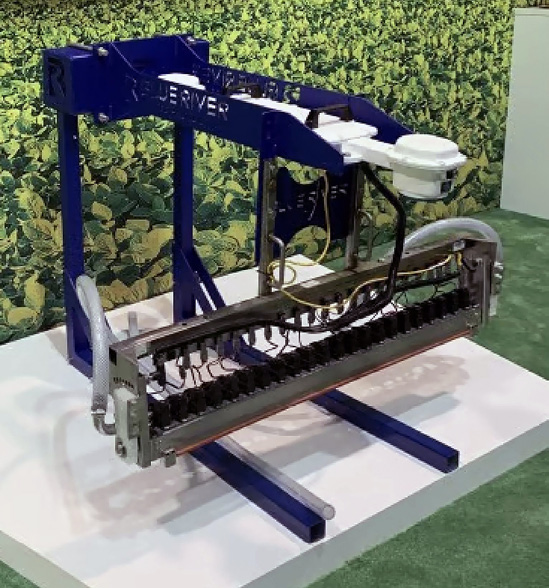See & Spray Technology

The overarching goal of precision agriculture technology is to reduce inputs applied in the field while optimizing management practices for improved sustainability and profitability. As the capabilities of precision-agriculture technologies have evolved, management zones have become smaller, allowing for more precise, targeted applications of crop inputs. See & Spray™ technology, one of the newest precision-agriculture product offerings, was developed by Blue River Technology, introduced to the market in 2017, and later acquired by John Deere for use on their self-propelled sprayers. The goal of this technology is to reduce herbicide use while increasing crop production by more precisely targeting weeds (Hamblen 2020).
See & Spray™ technology is an application approach that utilizes computer vision and machine learning in order to precisely apply herbicides only where weeds are present. This technology allows growers to strategically use herbicides for weed control, which, in turn, saves the grower money, time, and resources. See & Spray™ Select gives growers the ability to potentially reduce herbicide usage by roughly 77 percent by spraying and targeting only the weeds present at the time of application (Kalcevic, 2022).
This technology has three components: see, spray, and artificial intelligence. First and foremost, the “see” component consists of two sets of cameras that work together to identify and calibrate the differences between weeds and desirable plants. The calibration and identification happen approximately 20 times per second while the sprayer moves at an average speed of 12 mph. With a database of more than 1 million images, this technology uses computer vision and machine learning to identify the weed and decide where herbicide should be applied. The “spray” component begins after the weed has been identified. Following weed identification, the machine activates the specific nozzle that best correlates with the weed location relative to the spray boom, and a precise amount of herbicide is applied directly to the weed (Kalcevic 2022). While the “see” and “spray” components are unique, the “artificial intelligence” component is what makes this technology cutting edge. Artificial intelligence is described as a decision-based operational control that uses sensing and perception of the environment to make necessary, yet safe, real-time decisions. In this case, See & Spray™ technology uses AI through an embedded graphics processor that was specifically built to differentiate a crop plant from a weed (Hamblen 2020). All three of these components combined allow for a sprayer equipped with See & Spray™ technology to target herbicide applications to weed locations only as the machine moves through a field. Because each nozzle operates independently, this machine can currently apply an herbicide in approximately 4-inch squares across the width of the spray boom (Hamblen 2020).
Currently, the John Deere See & Spray™ system builds on the John Deere ExactApply™ system featured on the 400 and 600 Series sprayers, integrating boom-mounted cameras, software, and data processors to detect weeds and target herbicide applications (Figure 1). In a 120-foot boom configuration, this system utilizes 36 individual cameras positioned along the boom for weed detection and location (Schrimpf 2021).
Utilizing data collected during system evaluation, John Deere states that targeted spraying and broadcast tank mixes using the See & Spray™ system resulted in 7 percent improvement in weed control while using 47 percent less total herbicide volume (See & Spray Ultimate Agronomic Trial 2021). Currently, See & Spray™ technology is offered with a dual-tank system, allowing the system user to apply two independent herbicide tank mixes in a single pass. See & Spray™ is not currently available with herbicide injection system capabilities. These solutions will allow for more efficient herbicide applications in corn, soybean, and cotton (John Deere launches See & Spray™ Select 2021). See & Spray™ technology allows for growers to maximize efficiency of in-season spraying applications by combining computer vision with machine learning to site-specifically target weeds and apply herbicides only where needed, in addition to the capability to use herbicide tank mixes with dissimilar chemistries to mitigate herbicide antagonism with the dual-tank availability.
Works Cited
Bedord, L. (2021, March 31). John Deere Launches See & Spray select. Successful Farming. Retrieved March 28, 2022.
Hamblen, M. (2020, January 9). Deere shows off smart weed control machine that relies on AI with Nvidia Chip. Fierce Electronics. Retrieved March 28, 2022.
John Deere launches See & Spray™ Select for 400 and 600 Series Sprayers. John Deere U.S. (2021, March 2). Retrieved March 28, 2022.
John Deere. See & Spray™ Ultimate | Precision Ag | John Deere US. (n.d.). Retrieved March 30, 2022.
Kalcevic, A. (2022, February 7). John Deere new see and spray technology. 4Rivers Equipment. Retrieved March 28, 2022.
Schrimpf, P. (2021, March 5). Deere launches See & Spray Select Technology. PrecisionAg. Retrieved March 29, 2022.
“See & Spray Ultimate Agronomic Trial.” John Deere. 2021. Retrieved March 27, 2022.
The information given here is for educational purposes only. References to commercial products, trade names, or suppliers are made with the understanding that no endorsement is implied and that no discrimination against other products or suppliers is intended.
Publication 3904 (POD-06-23)
By Parker Dulaney, Graduate Student, Agricultural and Biological Engineering; J. Wes Lowe, PhD, Assistant Professor, Agricultural and Biological Engineering; Darrin Dodds, PhD, Professor and Head, Plant and Soil Sciences; and Cori Speights, PhD, Extension Associate I, Biochemistry, Molecular Biology, Entomology, and Plant Pathology.
The Mississippi State University Extension Service is working to ensure all web content is accessible to all users. If you need assistance accessing any of our content, please email the webteam or call 662-325-2262.



